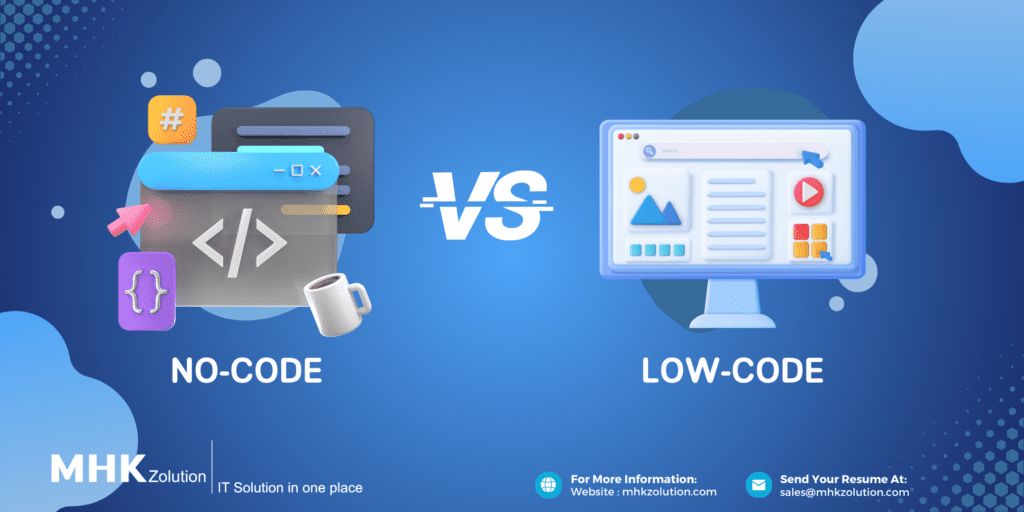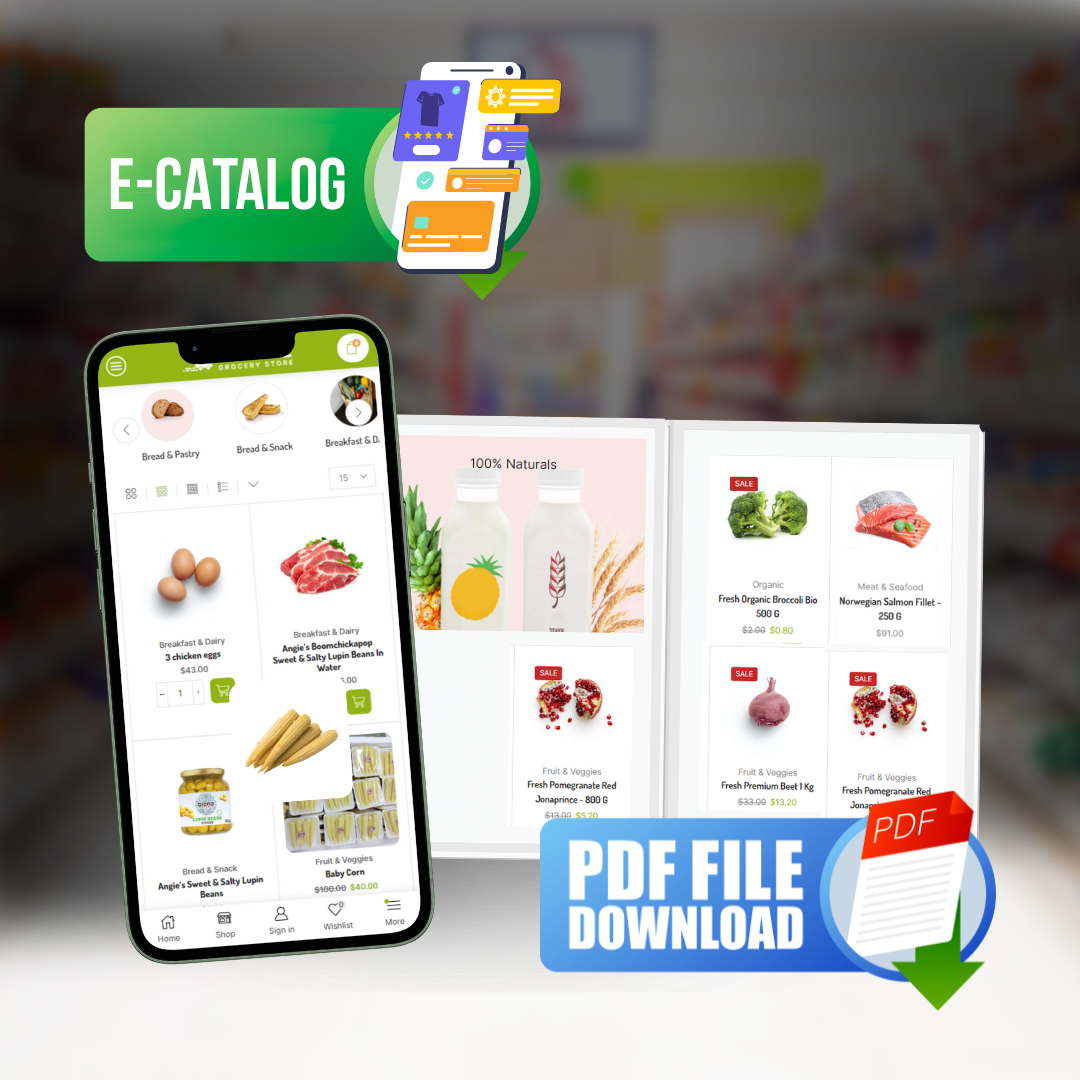Low-code and no-code technology have changed the digital world regarding creating applications and CRM systems that have become available to users without programming skills.
The No-Code Low-Code tools provide close compliance with business requirements, allowing faster implementation of tasks, and are much cheaper than in-house programs. Companies may save up to $4.4 million by not hiring two IT developers. These businesses only need to invest half of this in no-code/low-code solutions.
These alternative app development approaches use an intuitive graphical interface to give users the capacity to design applications and automate business processes without writing code line by line. Adopting LCNC (Low code no code) platforms is the next step in creating faster, affordable solutions.
Now it is time to understand how low code no code platforms work, what capabilities they give, where they can be used, and when it is the best option for business. Let’s dig into it!
What is low-code no-code development?
In traditional development, programmers write lines of code to generate the functions and features requested in application. This method needs that programmers be well-versed in computer languages such as Node.js vs Ruby on Rails, deployment processes, and testing standards.
Best low code no code platforms manage all the work done behind the scenes. Their users visually pick and connect reusable components representing certain phases (including the actual code) to construct the automated process.
Instead of writing line-by-line scripts for each required function and capability, users may construct applications as if they were creating a flowchart. These platforms often include exploring, prototyping, testing, and deploying tools. LCNC is not a one-size-fits-all solution. It can significantly reduce the MVP development time and the product to go to market. In case, this platform is used not by a user without skills, but by a skilled developer.
In this article, we tell in more detail about the usage of low code no code platforms for development.
No-code
There are several approaches to getting your application from concept to launch, but one that is usually ignored is a no-code approach. No-code allows employees to create applications without programming skills with little effort and resources. It helps businesses accelerate, quickly adapt business processes to market changes, and increase employee satisfaction. No-code developers use the code simply by clicking, scrolling, and dragging visual interface elements.
For startups who need to test the product, this allows you to present the MVP as early as possible and collect feedback from the target audience. No-Code tools can make it easier to modify or update some existing applications by adding or removing blocks as needed. In this case, the person in charge of no-code technology should be sure that the new modules will be properly integrated with the existing ones. Otherwise, nothing will work.
Main outtake: No-code is a visual instrument between the programming platform and end users through which they can create and customize the visual appearance of the software without coding. No code is fully hands-off.
Low-code
Low code is a rapid application development approach where you can create automatic code through visual building blocks such as point click, pull-down menu interfaces, drag and drop all the no-code capabilities. Low-code development provides more control over customization as developers will encode important company features.
Instead of programming languages, companies may use low-code platforms using visual interfaces and ready-made, pre-written universal blocks. Technology enables applications for a wide range of users without programming expertise. This allows you to save money on development and launch projects even with zero budget, a simple app can be made with your hands-free. Low code can help a company’s developers improve performance as they can create more solutions simultaneously.
It’s kind of like your hybrid car, where you can plug in and get electricity to run your vehicle, but also you can power it with gas when that is not enough there. So it’s like the best of both worlds you can achieve.
Low code development has the potential to transform IT, making it easier for enterprises to manage the complexities of application development rapidly.
You may also be interested in: Minimum Viable Product (MVP) Development for Startups
Difference between low-code vs no-code
Low-code and No-code are created to improve speed of development and expand business opportunities. The two techniques are similar, but there are differences. At first, no code platforms are 100% visual, while low code is a combination of visual and code scripting.
Need for coding skills
Low-code solutions target customers with coding experience or developers who need to quickly design programs by leveraging visual development environments and automated connectivity to back-end systems, databases, web services, or APIs.
No-code solutions take it a step further, providing visual drag-and-drop interfaces that don’t require coding. The technical background will be a plus for both.
Speed of development
No-code tools are built based on a quick programming methodology, which helps perform tasks as fast as possible. This helps entrepreneurs and small businesses to create working prototypes.
Low-code requires developers to code certain parts of an application, increasing development time.
Application
No-Code technologies are best used to create tools that can help with workflow management, progress reporting, project tracking and analytics, and small online stores or flexible applications that can be developed and improved by updates and changes depending on your unique use.
Low-code creates applications that can have many complex functions. It can be used to develop a prototype that lays the groundwork for further programming and to launch critical business processes.
However, advanced platforms have features that allow you to create complex corporate-level solutions almost without writing code.
Safety
No-code monitor compliance with security standards supporting certificates that will help instill confidence in their services.
Low-code platforms also follow the same standards.
Generally, having a full-time developer who independently monitors digital security will be the most safe solution for any company.
Detecting bugs
The no-code system is not a subject to a manual encoding errors, as users do not need to write their code to create applications.
Low code is vulnerable to errors, as it is possible to improve or modify certain functions. The human factor can also lead to mistakes and problems in the future. Meanwhile, low-code platforms provide many tools for QA specialists, such as scenario testing, reporting bugs, etc.
Customizing
No-code systems generally do not have great configuration functionality. This can be a problem for those who want to customize apps according to certain business requirements.
Low-code platforms offer huge customization capabilities as users can code and modify items according to their needs.
Integrating
Most low-code and no-code platforms can be integrated. As the need for various services and applications has grown, it has become necessary to integrate with other applications to ensure the smooth exchange of information and data.
What is the main difference between low-code and no-code? If some functions or missing options you want to add with ordinary code, then choose low code. If you don’t need additional features and integrations, choose no-code.
Benefits of low-code no-code platforms
Both low-code and no-code strive to the difficult coding components through visual interfaces and pre-configured templates. Both development platforms are offered as PaaS solutions and use a workflow-based design to specify data flow.
81% of developers stated that low-code no-code development has led to close collaboration, according to Microsoft low-code trend report 2022. Let’s find out why?
Rapid prototyping
When developing a software program, you will most likely need to go through several iterations until you get the version that best meets your needs. Simultaneously, developing your prototype from scratch in a typical programming language like Node.js vs .NET is a time-consuming and rigid procedure.
Fortunately, you can prototype more quickly by using no/low-code technologies. Developers and non-technical users may construct high-fidelity drafts easier than before by dragging lego-like pieces on a canvas and setting parameters.
Try to use a low code no-code solution to validate an idea that allows you to save time and money. If it’s going to be useful, rather than spending months, weeks, months, years, or more building an application, you have no idea if it’s even going to validate whatever assumptions you have.
Lead to higher productivity and user experience
Businesses demand developers to provide apps faster than ever to satisfy their needs promptly. Low-code development is a feasible alternative since it allows developers to deliver apps quickly and effectively, resulting in increased productivity.
82 percent of low and no-code users agree that the technology provides software consumers with a chance to expand their technical and development expertise. Additionally, it has been demonstrated that the usage of no-code or low-code platforms or applications has an 83% good influence on users’ job satisfaction and workload, as well as an 80% positive impact on users’ experience.
Based on Out Systems Survey, 46% of low-code users indicated their organization’s backlog of web and mobile development projects has improved. Low-code no-code also gives a better user experience by granting users complete control. It makes it easier for companies to use the app’s sophisticated features and clean, intuitive user interface for day-to-day operations, thereby improving the customer experience.
Scaling
Low-code no-code platforms reshape sectors and alter how businesses compete. It allows firms to start small and then scale up to adapt to changing conditions in the future. Businesses can start with simple progress to hybrid or native applications.
Furthermore, low-code can improve the capacity of deployed programs in response to changing corporate requirements. It makes it simple for organizations to scale up in a matter of days, from storing data in Excel spreadsheets to scaling it up to MS SQL using Common Data Service. Companies use the cross-functional front end when your chosen low-code no-code platform handles all backend processes.
Faster development and deployment
Low-code no-code development is 40 to 60% quicker than traditional development. Low-code no-code accelerates development by eliminating IT backlogs, shortening project deadlines from months to days, and allowing for speedier product rollouts.
According to Project Management Institute research, high-code app development has regular delays in the development process in comparison to low-code vs no-code development. Application development with high code is a repetitive and time-consuming process that might take more than a year. On the hand, a low-code platform enables speedier application delivery, is resilient to delays, and has fewer issues than heavy code.
Low-code no code platforms employ boilerplate code, pre-built templates, and other “components” to reduce the development process. Furthermore, the point-and-click interface with drag-and-drop functionality makes it exceedingly simple to create apps.
Faster innovation & agility
The popularity of low-code and no-code solutions speaks for itself – since the inception and distribution of these tools, the work of creating sites, services, and programs have accelerated and simplified. In addition, the niche develops – every month, there are more diverse and perfect solutions. While initially, no-code allowed making, for example, the simplest one-page sites for business, now it is possible to create sites and applications comparable in complexity to Airbnb or Facebook.
Lower maintenance burden
A unified low-code/no-code platform enables design and code consistency for cross-cutting modules like logging and audit. This consistency is also advantageous for debugging programs since developers can focus on analyzing bugs rather than learning frameworks.
The platform itself can function in different software environments. On the other hand, you can use it to create applications that are compatible with different operating systems and run on different devices as web applications.
All low-code no-code platforms support you on any questions and issues you have. There are forums to ask in the active user community and user-friendly websites with the most popular FAQs.
Lower development cost
Big development teams are expensive with front- and back-end developers, UX/UI designer, BA and Project Manager. Low-code no-code allows them to be replaced, which means that businesses will be able to allocate resources to other needs. Moreover, as it speeds up the work process, the company saves man-hours, which leads to increased revenue in the long run.
Because of smaller teams, fewer resources, cheaper infrastructure expenses, and reduced maintenance costs, low-code/no-code development is more cost-effective than ground-up manual development.
It is difficult for a small business to hire a professional or outsource the project concept mainly due to financial constraints. Small business owners benefit from improved customer interaction without a huge investment in development.
Disadvantages of low-code and no-code development
Sometimes low-code no-code platforms may not suit your software development needs. Let’s find out which milestones are the drawbacks of LCNC.
Lack of templates for untypical solutions
In LCNC platforms, everything is the same as with modular furniture assembly: to make a space that will serve faithfully and quickly, you can easily and quickly, but creating a design product – will not work. Assembling from blocks an application or site, you will have to rely on the tool’s capabilities and the presence of templates. Sometimes, for a particular business product may not be enough blocks for a result.
Project depends on the platform
Not all platforms provide the opportunity to pick up their product after development by downloading the source code. The platform often works as the engine on which the site/application remains. There are risks here: the platform may close, the quality of service may fall, or the existing functionality will no longer be enough.
It’s hard to pick the right platform. There are many services and platforms for no-code, but you need to know what functionality you need and which platform has the necessary features and templates. Because services differ, each has its specifics, products, and features.
Training
Still, the more professional functionality of the platform – the more you will have to go into the process or hire the low code no code developer that knows how to integrate and scale up your app and automate better work processes.
Low-code and no-code solutions
Database
Most platforms are either pre-connected to a server-side database or provide custom configuration to connect to the required database or use internal databases through connectors such as AWS databases, Microsoft and others.
BI reporting and dashboards
If you’re a business intelligence analyst or programmer, you’ll need the best reporting tools to turn raw data into relevant insights. You’ll discover that no-code solutions are just what you’re looking for. With no code, you can gain real-time access to your corporate data and turn it into usable data grids, visualizations, and important statistics.
Applications for data management
Using a no-code platform, you may connect your data sources to any database, such as MS SQL Server, MySQL, PostgreSQL, and others, and alter, add, delete, and update information. Clients may quickly and simply construct database apps. Information collection, storage, sharing, and collaboration become simple. Your code-free custom database has a modular extendable structure, a configurable interface, data export/import functionality, and ready-to-use templates.
Cutting-edge technologies
Many low-code no-code systems feature a substantial collection built by industry experts and the ability to integrate third-party cloud digital solutions such as AI, machine learning, cryptocurrency, and facial and voice identification services and access tools.
Pre-built user interface designs for customer experience applications for mobile are intended to help you boost user-friendliness and adoption while maintaining brand marketing integrity.
Employment of low-code no-code
When companies start using LCNC tools, user numbers and app’ complexity rocket. Supply chains can construct apps to assist them in overcoming a variety of obstacles, such as pandemic-related delays, and trade penalties, all of which can disrupt supply networks. Mostly, LCNC tools can help in three key ways:
- Creating dynamic and progressive apps for collaboration and end-to-end visibility, as well as improving supply chain trackability and traceability
- Developing automated workflows and business processes to model, monitor, and enhance supply chain operations, from raw material procurement through customer delivery at the front door.
- Digitizing old data and records and merging them with current and new incoming data allows for more accurate analytics and stronger data-driven insights.
Who needs to use low code vs no code platforms?
Accounting and finance teams create tailored business apps to suit a variety of workflows and information management procedures. An accounting firm may develop a site to assist customers through the process of reporting costs and income, providing bank statements and other financial disclosures, and minimizing the flood of emails and printed papers by establishing tax filing routines.
Human resources departments personalize job postings, automate recruiting procedures, screen prospects, and develop full training programs. These actions may now be carried out without taxing the IT teams’ resources.
IT departments streamline complicated operations while increasing efficiency and agility. Furthermore, firms may eliminate IT bottlenecks and overwork by increasing the number of citizen developers. IT departments may still oversee and execute LCNC programs, but they are spared from the tedious and time-consuming code-writing responsibilities traditionally connected with that process.
- According to current estimates, more than 60% of LCNC development initiatives include collaboration between IT specialists and business users.
- IT departments also use LCNC for process automation projects like business processes (BPA). This can involve data reading and entry, information extraction from documents, and other rule-based operations.
Now you know what you can do with low-code vs no-code platforms, keep reading a short review of the best platforms.
Best low-code no-code platforms
Each LCNC platform has a drag-and-drop user interface and templates for creating web applications and online stores for business. But they have different functionality in delivering analytics systems, processing payments and transactions, automation of business processes, and integrating with other apps.
Outsystems
OutSystems updates and deploys apps with a single click, and it automatically analyzes app requirements to manage deployment. OutSystems also allows you to investigate models and rework dependencies easily. It helps develop mobile-friendly apps with native device access and on-device business logic.
Mendix
Mendix provides end-to-end process automation with apps that connect systems, data, and people. Furthermore, you may incorporate logic and data from any source, service, or system, making your apps adaptable and open to new platforms, apps, and models.
Airtable
You may create remarkable apps by combining your vision and the power of Airtable. It will assist you in getting started fast since it combines the power of a large database with the familiarity of spreadsheets and integrates your applications with services such as Slack, Gmail, Facebook, Twitter, Teams, and Google Sheets.
Bubble.io
Bubble.io supports password-protected logins and any OAuth 2.0-compliant user authentication system such as Google, Facebook, LinkedIn, and others. It provides complete control over the functionality using JavaScript plugins and API integrations, manages search engine optimization, tracks app usage restrictions to make payments easier.
TechMagic’s low-code no-code app development experience
With low-code no-code, TechMagic produces web applications faster than traditional development. Our technical professionals create low-code bespoke apps with model-driven and canvas-based Apps using the Bubble.io platform.
With Bubble, JS, MongoDB, Liquid HTML, and PDF Monkey, we created an Invoice app to manage internal and external accounting and invoicing processes within the IT company. A “no-code” solution with complex features, third-party integrations and custom UX for desktop and mobile web browsers.
Learn more about our low code/no code development services, and let’s discuss if it’s the right solution for your business.
Conclusion
According to International Data Corporation, about 500 million digital services and applications will be created and deployed by 2023, equaling the number of apps created in the previous 40 years.
Low-code no-code allows you to build custom apps that accept payment restrictions, access to content, and a lot of the things that you required developers for before. Creating services with low-code no code allows you to implement almost any idea, digitize routine processes and develop your application — all without the traditional programming, just with the low code no code specialist.
Your goal should not be to write code. You may maintain the goal to ship a business that provides value and has economic benefits to yourself. It’s time to try and discover all the opportunities of low-code no code!
Low-code VS No-code FAQs
- What is low-code no-code?
Low-code no-code is a series of tools, platforms, and technologies that allow you to build applications with no-code nothing. No code encompasses1 the ability to connect multiple tools to create a different type of application. Some of these platforms allow you to write a bit of code that you can update particular parts of the site or a web application maybe you can drop Node.JS vs Java in there and modify a bit. - What is the low-code no-code platform?
Some of these platforms are all-inclusive. You can build an entire web or a mobile application just by clicking and dragging different components onto a canvas and connecting things up. Then you, in the end, have a working web or mobile application. - Why low-code no-code?
Because many business users and people who are not technical can take the idea and build something in real-time by connecting the dots. it allowed business folks to develop something, test it provides value prove a market prove a concept. LC/NC automation minimizes errors and speeds up business operations while reducing the number of routine and redundant tasks. Most teams choose these tools to speed up and simplify their routine work. Low-code and No-code also make it easy to create and test early prototypes of future projects. This accelerates the work with investors and allows you to collect the first feedback from potential future product users. - Is low-code only suitable for large companies?
Just the opposite—this method is universal; it is perfect for small businesses, start-ups, and any organization or individuals due to its simplicity and cheap use.




























